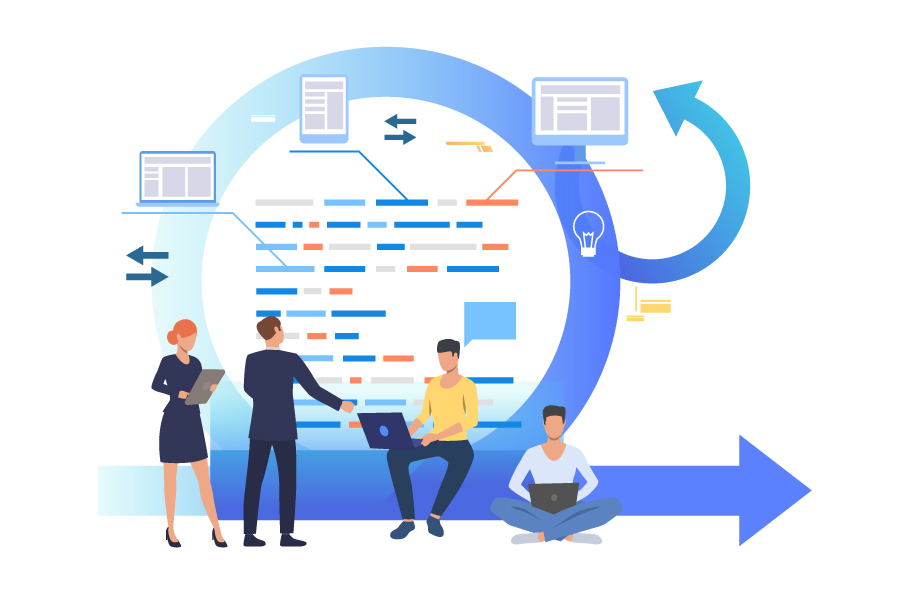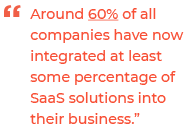October 30, 2019 - by Miguel Sanchez
Choosing the best software for your business has never been easy, and these days, sorting through the seemingly never-ending options of Software as a Service (SaaS) models is exhausting.
Clients often come to us having a sense of what they want, not quite sure why they can’t just go pick something up from Best Buy, install it and be done with it. Most don’t understand how SaaS became popular, or why choosing a SaaS vendor is just as important as knowing what features will impact their business.
The Early Days of Software as a Service (SaaS)
When SaaS was in its infancy, the computer had already been established as a tried and true business tool — but the ubiquitous nature of the web was just reaching its peak. In addition to the prevalence of internet connections in the workplace, major players such as Google, Amazon, and Microsoft were developing new tools that could help businesses store more data in the cloud. |
These, combined with a proliferation of online tools, ushered in a new era of computing — one that had previously been focused on increasing speed and power. It was the perfect storm, with conditions favoring the rise of all things online.
In a time when CDs full of software could regularly be found on the shelves of businesses everywhere, the idea that companies would no longer have to pay for updates shipped when it was convenient for their maker was unheard of.
The software business centered around the creators, and customers were subject to the development timeline the developers felt like adhering to, at any price they could get away with charging. Hidden safely behind their partner resellers, many software companies felt protected from the idea that things could ever change. To think that customers had a voice strong enough to influence the direction a creator’s software would take, much less when it would be available, felt lofty and esoteric.
Then Salesforce entered with its groundbreaking “No Software” slogan, and the brave new world of SaaS finally took hold. (Software still existed, of course – or, “applications”, as they’re often called today – but the traditional notion of on-premise models involving physical data was on its way out). With its promise of regular, scheduled updates and ever-evolving features, Salesforce ushered in a whole new paradigm that felt like a customer-centric breath of fresh air.
A New Software Delivery Model
|
“Our clients look to us to protect their best interests when considering how these applications can benefit their business.” Finally, the struggle of trying to keep up with the latest and greatest software had seemingly vanished: Everything was available online, to everyone, quickly. Vendors could easily apply changes across all customers’ applications at one time and develop products that felt more like something businesses would have created for themselves. Prior to SaaS, customers could request custom software that was tailored to their business — for a price. |
The online delivery model introduced the concept of configuration (as opposed to customization), where pieces of the application were purposely built to be interchangeable. Customers could suddenly add their own logo, even if they couldn’t change where it appeared on the page and use Application Programming Interfaces (APIs) to connect with their own systems, even if they were clunky at first.
The blushing promise of a new delivery model turned both customers and vendors into huge SaaS fans very quickly. Businesses who jumped in early reveled in the new concepts, even when they eventually discovered the limitations of configuration.
The realization that too much tweaking meant losing out on new features in the ever-available updates made it easier to give up this newfound sense of control, especially when mobile versions of tools were suddenly possible. Vendors no longer had as many costs associated with producing or shipping physical discs and were able to shift to catering on customers’ ever-changing desires.
Being able to quickly see the effects of their development across an entire customer base also meant vendors could better advise their clients, once again positioning them as knowledgeable resources.
SaaS Today
Constant AdaptationsYour business has to be ready
|
Eventual ObsolescenceThe application you originally
|
Subscription FeesYou may not be paying as much
|
Security ConcernsNew security concerns
|
Since vendors now hold the data, customers need to ask directly if it can be retrieved at any time. Vendors can now see every transaction, which means requesting that data (or even running a report) can become a chargeable event.
The continuous change cycle introduced by SaaS models is unrelenting and feels much more developer-centric than the original premise would have us believe. Recently, the pendulum of configuration has swung back in favor of “plain vanilla” implementations, and many businesses find themselves having to undo at least a portion of the original work they put in. Those who favor the latest and greatest find themselves spending more than they anticipated to make sure their users are always up to speed on the new features, often resulting in additional training costs and lost productivity time.
Subscriptions Continue to Increase
Despite these growing pains, companies using cloud-based apps with the SaaS business model are increasing in number because it’s based on the subscription model and has numerous benefits. SaaS is proving to be the solution that meets organizational requirements like data security and high performance — all while we watch age-old business applications continue to fold out of many business’s IT plans. |
The numbers don’t lie, according to the Computer Economics report, around 60% of all companies have now integrated at least some percentage of SaaS solutions into their business, with nearly 36% aiming to increase their investment in the months to come.
If you’re overwhelmed and in reactive mode, struggling to stay competitive due to outdated applications and systems, Synoptek can help. We believe no business should be left behind because they can’t keep up with the change of technology.
Download PDFAbout the Author
Miguel Sanchez is VP of Professional Services at Synoptek, a Global Systems Integrator (SI) and Managed IT Services Provider (MSP) offering Comprehensive IT Management and Consultancy Services to organizations worldwide. Miguel is responsible for strategy development, business growth, and client relationship management for Synoptek’s consulting practice. . With over 18 years of experience in developing IT strategy, leading business solutions by leveraging best practice process methodologies and managing large-scale IT solutions, and systems implementation.




